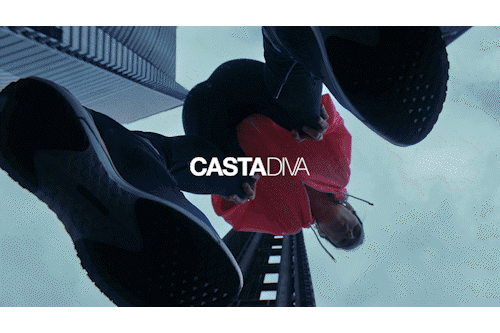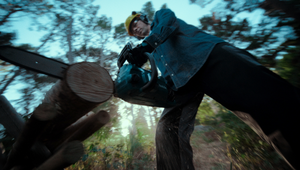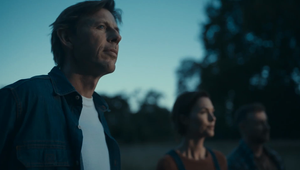
New Talent: Allison Lenz

Allison Lenz always knew she wanted to work in the creative industries; as a shy kid she whiled away hours painting and crafting sculptures which her parents proudly hung around the house. She has a fine arts background but these days finds herself working in digital design at Isobar’s Boston office. At just 24 years old she has made a big impression on the agency’s creative directors and has risen through the ranks from entry-level to senior visual designer, and finds herself working on the LEGO and Royal Caribbean Cruise accounts. Her extracurricular activities are also something to be marvelled at. LBB’s Addison Capper chatted with her to find out more.
LBB> Where are you from and what kind of kid were you?
AL> I grew up in Atlanta, GA and lived there until I moved to Pittsburgh, PA for undergrad at Carnegie Mellon. As a kid, I was into all the usual adventurous things: playing with American Girl dolls, building blanket forts with my younger brother, swimming in lakes, and drawing on pretty much any piece of paper...or wall – oops. When I was old enough to read, I would bury my nose in a book for hours at a time. I loved getting lost in stories, and still do.
LBB> You’re a visual designer at Isobar – do any of your childhood traits stick out as a signal that you’d make it good in the creative industries?
AL> When I was a kid, I was always drawing or making something. I used to get in trouble in my first grade English class for drawing in my composition notebook instead of writing. Overall, I was pretty shy growing up, which is possibly why I liked art so much: I was able to express myself best through my artwork. My parents were really encouraging, always hanging up my paintings around the house or finding a place for that little clay sculpture. It was obvious that I had a passion for art from a very early age, which made it easier for me to figure out what I wanted to do when it came time to apply to college.
LBB> How is it that you came to work in design? Was it always the plan or a bit of an accident?
AL> I always knew I wanted to do something creative with my life. I briefly flirted with the idea of becoming a fine artist or a fashion designer, but my parents – who are both accountants – wanted me to pursue a career path that they perceived as having a more stable income. Finding graphic design was kind of a happy accident. I wanted a career where I could be artistic, but one that involved creative problem solving with other people. I didn’t want to produce work as an act of self-expression; I wanted my work to help others.
What really flipped the switch was when I talked to my aunt, who is a graphic designer and runs her own business. Seeing her work opened my eyes to the world of graphic design – who knew it was someone’s job to design all the signs in museums or hospitals?! Or all of the books ever made! From there I looked at every college with a graphic design program that came to my high school’s college career fair day. And I fell in love...with Carnegie Mellon University School of Design.
LBB> And so that’s where you learned your craft?
AL> My undergraduate experience at CMU challenged and shaped me as an aspiring designer. Before that I had only done fine art, exploring mixed media, sculpture, and drawing. Coming into my first year of design school, I had a working knowledge of color and composition, but had no clue about typography or anything system design related. In college, I started to learn what design is really all about and how to go about honing my craft. My professors played a huge role in my development as a designer, knowing exactly how to push me further or reel me back in. Being surrounded by so many talented classmates was another great motivator to work harder. My peers and I learned to love our intense group critique sessions, taking our ideas and working together to turn them into something even better. I couldn’t be more grateful for the opportunity to have studied at a design school that championed user-centered design in everything we did. During my time at CMU, I was also able to study abroad for a semester at the Schule für Gestaltung St.Gallen (School of Design St.Gallen) in Switzerland, which exposed me to the different ways in which culture shapes design decisions, and why it is so important to know your audience...and your typography!
LBB> It’s a great achievement to be a Senior Visual Designer at just 24 years old. When and where did you career begin and how did you rise the ranks?
AL> Thank you. It constantly amazes me too. Three years ago I started my career with Isobar – called Roundarch at the time – after completing my undergrad. The company, along with a hoard of others, came to CMU in my senior year to recruit designers during the annual creative career fair. That was my first introduction to Isobar, but not my first introduction to digital. I had a fantastic internship the summer before at NPR in Washington, D.C. as the User Experience and Editorial Design Intern. Coming from a design program that touched on digital media but focused mainly on print, I finally got a taste of how to design for digital spaces through NPR.org. I decided I wanted to pursue a career path in digital, which led me to Isobar.
I started at Isobar in Boston as an entry-level visual designer, working on various clients over the course of the first year and a half. The projects ranged from conceptual design work, to detailed design production work, to everything in between. That’s one of the great things about Isobar: I got to work on conceptual design projects straight out of school. It was slightly terrifying at the time, but as a result I learned to think quickly even when outside of my comfort zone. My design skills evolved steadily in the face of complex design problems. To put it simply, I was presented with a lot of opportunity and I worked my ass off. In this business, pure talent only goes so far; the rest comes from hard work, teamwork, and determination. A key turning point in my early career was my work as part of the team that designed and implemented the fully responsive redesign of the Cruise Planner site for Royal Caribbean Cruise Lines. I collaborated with creative, UX, and technical team members to conceptualize, design, and build an e-commerce experience revolutionary to the cruise industry.
LBB> Your role involves working on the LEGO account - how is it working on such an iconic, adaptive and playful brand? What challenges does that experience bring?
AL> Growing up, I loved playing with LEGO bricks, so in a way it’s a dream come true. Prior to joining the LEGO account, I worked with more serious brands, so while the change was refreshing, it was also a challenge to break out of that expected formality and harness the playful spirit necessary to design compelling digital experiences for kids. Designing for children also brings another set of challenges. Given COPPA regulations restricting how brands can advertise to children, what we design needs to respect those limitations while still providing engaging online experiences that get kids excited about the latest, coolest LEGO sets. At the same time, parents also see LEGO as a respectable and trustworthy brand, a perception that LEGO strives to uphold, so naturally our work must also live up to parents’ standards and expectations. As The LEGO Group’s US digital agency of record, Isobar has the opportunity to bring a brand with so much physical play value, multimedia content, and brand equity into the digital space in a way that extends the brand in a meaningful way. It’s exciting to be a part of such an awesome team!
LBB> Which pieces of work that you’ve been involved in recently have you particularly enjoyed and why?
AL> I played a key role in the design of the LEGO Elves site experience on Nick.com, which launched in May. It’s a fully responsive, immersive site that introduces the LEGO Elves theme to kids aged 7 to 11 who are drawn to fantasy over reality-based play. I really enjoyed every step that went into designing and building this site. It was one of the first projects where I got to own most of the visual styles, and see it through from start to launch. With LEGO Elves being a new theme for LEGO, our team had the freedom and opportunity to define many of the brand styles for the digital space. Overall, the LEGO Elves theme revolves around a central storyline, which lends itself extremely well to discoverable story pages, interactive maps, and playful site animations to bring the magical world of Elvendale to life. It was a highly educational and rewarding experience to work so closely with the front-end developers in order to problem solve how to make the site as interactive as possible without sacrificing performance.
LBB> You’re based in Isobar’s Boston office. How do you see the city’s culture, creatively, when compared with other bigger U.S. cities like New York?
AL> What I love about Boston is that it is such a small creative community, especially in advertising. Everyone sort of knows everyone, and paths often cross again and again. Despite the inter-agency competition, one thing is clear: the creatives of Boston are fiercely loyal to this city. At the end of the day, we want to produce great work and make a name for ourselves and for our city. Now, I have never actually worked in New York, and I have only visited a handful of times, so I do not pretend to have a fair comparison. What I will say is that there is an incredible amount of creative talent here, not just in the agency world. An inordinate amount of startups are popping up all over the Boston area, which cultivates a fantastic spirit of innovation and entrepreneurship. In many ways, designers in Boston have the opportunity to lead and influence large initiatives alongside the technologists and the business professionals. That kind of go-getter attitude is exhilarating and contagious.
LBB> You’re also a part of the Internet of Things group in the Boston office – can you tell us a bit about that and why it’s something you enjoy doing?
AL> The emerging technologies behind the Internet of Things are fascinating to me. Everything in our lives is becoming increasingly connected, which can be exciting and scary at the same time. What the group at Isobar’s Boston office does is explore, discuss, and play with the latest technologies, from 3D printing to connected appliances to drones and beyond. It’s a way to stay informed on what’s out there so I can experiment with ways to use these technologies to improve people’s lives.
LBB> And then there’s ‘A Bout to Benefit’, a charity event that you handle the digital design and social media for. What is the event all about and how did you get involved? How does your role there impact the event?
AL> A Bout to Benefit is an annual white-collar boxing event that raises funds for pediatric cancer research through the Michael J Dunleavy Foundation. The Foundation was named after the Dunleavy family’s 8-year-old son, who died of an inoperable brain tumor, but whose altruistic spirit inspired the family to continue to organize ways to support other children battling cancer. A Bout to Benefit recruits a group of twenty-four men and women to undergo several months of introductory boxing training to prepare for their night in the ring. The amateur boxers tap into their social networks to spread the word and support the cause through ticket sales, sponsorships, and donations.
I got involved in the event through one of my colleagues, who came up with the idea for a charity boxing event with a few of his friends and proposed it to the MJD Foundation. The event committee needed someone to design the poster for the event, and I was happy to help out for such a worthy cause. What started as an analog awareness campaign that relied heavily on word-of-mouth quickly took digital form over the next year. After the inaugural event, it became clear that future potential event attendees needed digital touch-points to discover, learn about, and share the event. For the next annual ABTB, the committee and I came prepared with a full-fledged responsive website and social media plan. The event needed the legitimacy of a well designed website and properly branded social channels to attest to the credibility of the Foundation and the event itself. With a cohesive digital presence, A Bout to Benefit can communicate its brand story in a way that resonates with people and speaks to the depth of selflessness and generosity that ensures the event’s success every year. This is an event for people, about people, with people. The event sells out every year with 500+ attendees and raises tens of thousands of dollars for charity. It is extremely satisfying to have an impact on something as important as pediatric cancer research through design.
LBB> When you’re not working, meeting with the Internet of Things group, and working on A Bout to Benefit(!), what do you like to get up to?
AL> In my free time, I love to read – actually it’s more of an obsession –go for bike rides, stroll through outdoor markets, and try new restaurants. Boston is a great city to live in, so I like to make the most of it when we’re not covered in 108.6 inches of snow!















